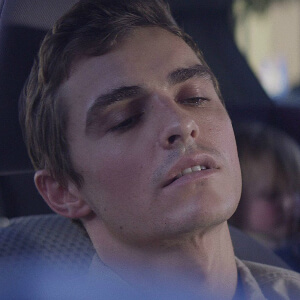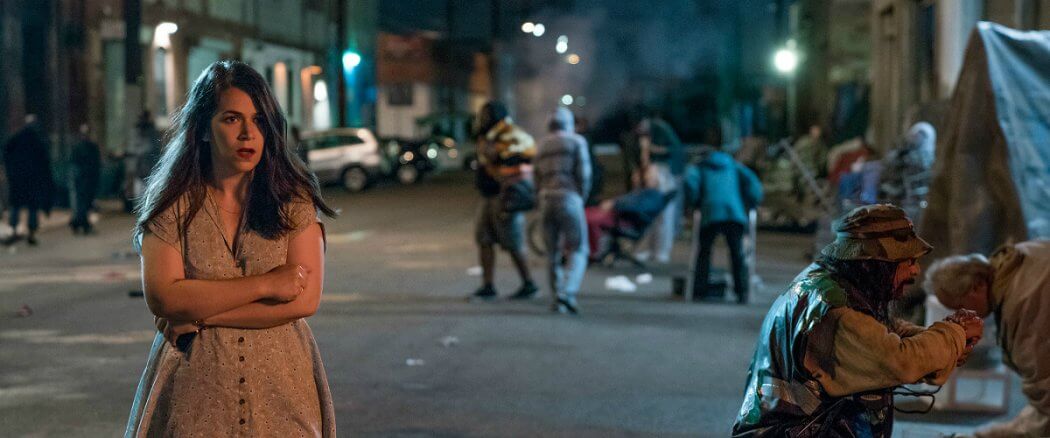In these times, hardly a family is untouched in some way by the opiate epidemic. As leaders of our church’s youth group, when my wife and I told the teens they could come to us with any issues — even when older and no longer a “youth” — little did we realize we would be counseling some of our “good kids” about how to deal with their opiate use. And in my medical practice (in a rural, out-of-the-way village), I had no idea I would be treating so many of my patients for addiction, as well as counseling parents how to deal with their children who were ensnarled in the tentacles of substance abuse. As a society we are facing a problem which is killing our adults and youth, the cost of which threatens to bankrupt our society as well as our social fabric. Seeing the deaths of the young teens and adults around me published in our small paper almost every week, and knowing what I am seeing is just a microcosm of what is happening across the USA, makes any film dealing in a real way with this overwhelming epidemic important to me.
The small movie 6 Balloons (only 74 minutes and having just a handful of notable characters) now streaming on Netflix was picked up by the media giant after receiving positive reviews at SXSW this year. Netflix quickly put it on their site with little publicity (as is often the case with thoughtful independent dramas). On Netflix, if it is not on the splash page most films soon lose the ability to rise among the crowd. That is a shame as this film deals in a realistic and thoughtful way with the issues of addiction, enablement and codependency.
“You’re On a Dock. You’ve Been There Before.”
6 Balloons has a unifying device of an audio-book, self-help meditative narration. The first words of the film — preceding any video other than a few opening studio credits — are spoken by a calm, almost hypnotic female voice “Welcome to Letting Go With Love. Chapter One: You’re on a dock. You’ve been there before…” As these lines are read, the troubled face of almost-middle-aged Katie (Abbi Jacobson) comes into focus. The sequence ends with the self-help narrator speaking of “gathering clouds,” “high winds,” and “unsteady seas,” and water splashes on our 4th wall… our monitor.
 We then break with the audio-book narration and hear instead a radio station talking about a typical sunny 4th of July in Los Angeles. We soon find out that Katie is readying a birthday party for her boyfriend with the assistance of family and friends. Her child-like, co-dependent mother played by Jane Kaczmarek (best known for Malcom in the Middle) is at Katie’s lower middle class home to “help”… but primarily to criticize. Katie’s female friends are helping to prepare hors d’oeuvres, although Katie feels obligated to do most of it herself (and to reroll the pigs-in-a-blanket since they are not quite right — along with hanging the decorations). Obviously she has learned much about codependency from her mother.
We then break with the audio-book narration and hear instead a radio station talking about a typical sunny 4th of July in Los Angeles. We soon find out that Katie is readying a birthday party for her boyfriend with the assistance of family and friends. Her child-like, co-dependent mother played by Jane Kaczmarek (best known for Malcom in the Middle) is at Katie’s lower middle class home to “help”… but primarily to criticize. Katie’s female friends are helping to prepare hors d’oeuvres, although Katie feels obligated to do most of it herself (and to reroll the pigs-in-a-blanket since they are not quite right — along with hanging the decorations). Obviously she has learned much about codependency from her mother.
Katie soon must leave to pick up her brother Seth who, it is understood without our being told, cannot drive. Seth also has visitation this holiday weekend from his lovely (3 year old?) daughter, Ella. Katie is immediately troubled with the appearance of Seth’s apartment (unopened mail scattered over the floor) and his own muted, ill-looking physical appearance. She soon asks him to roll up his sleeves to show her his antecubital areas — which Seth will not do. Katie realizes that Seth has, once again, fallen off the wagon and started using heroin… just like the last time. She sees that he is in withdrawal and she cannot have him at her party while he is “sick.”
Much of the rest of the film involves Katie’s efforts to get Seth into a detox and treatment center. When that cannot be accomplished, she reluctantly agrees to buy Seth a hit. Small amounts of heroin or “black” are often sold in tied off balloons, thus our title. She hopes the heroin will help Seth enough for the evening that she can still pull off her boyfriend’s long-planned birthday party, and then she will work on her brother’s problems “tomorrow.” Seth, due to his addiction, will need “6 balloons” to get out of withdrawal. The scenes of her buying heroin in the worst parts of LA are harrowing.
“You are Sinking. You are Drowning.”
The entirety of 6 Balloons covers one afternoon/evening — only a little more than the running time of the film. While there is little back-history of the characters, it would appear Katie’s closest family relationship is to her brother. Her father seems distant and her mother passive/aggressive (among a small garden of neuroses). And when Seth is with Katie, and he is not jonesing, they display the warm back-and-forth demonstrated by siblings who can say almost anything to each other, even being critical, with a loving smile. But she has played the role of rescuer many times before and she is growing weary. Everyone else has given up on Seth, but she is the “good, responsible” daughter… the one on which everyone else can depend.
So Katie struggles with — once again — what to do about the problem in her life which dominates all others and which no one else will solve, or even try to do. At one point her boyfriend says “There’s nothing anyone can do for him, babe.” She replies “You want me to just leave him?” And of course, that is the dilemma hundreds of thousands of family members, spouses, children and friends face in this country. The absence of any reliance of faith in Katie’s family is noticeable (at least to me) but then, how much have our churches helped those families who are being devastated by substance abuse? In my experience some addicts can get clean individually (often using their personal God-relationship) but most need medical treatment — and most of them need that treatment more than once. It is demoralizing and exhausting for all involved.
Contrasts
The device of the self-help narration continues throughout 6 Balloons all the way up to the last chapter of the audio book — ten. Some viewers have found this device to be annoying but for me it was thought provoking. It reveals Katie’s inner voice as she struggles with what is her “duty” as a daughter, sibling, and aunt – and how far she should go out of unconditional love. When does the “unconditional” become counterproductive? It is interesting to contrast the self-help voice with the GPS voice in Katie’s car as she drives around Los Angeles. When she diverts her route from taking Seth to a detox center and instead cruises skid-row to buy him heroin, the GPS voice urges her to “Turn Around.” When Ella becomes aware of her frightening surroundings from her child’s rear seat, she too begs “Turn around.”
 There are many effective scenes of contrast in 6 Balloons. The happiness and laughter at Katie’s boyfriend’s surprise birthday party contrasted to the anger and sadness of Seth’s relapse. The pleasure of picking up the birthday cake and a cupcake for Ella contrasted to Katie changing Ella’s soiled diaper in a filthy bathroom where in the next stall Seth shoots up using water from the toilet to mix his heroin. Katie’s fastidious preparation for her boyfriend’s party contrasted to her steadfast determination to bargain with drug dealers in squalid LA slums. The embarrassment of carting a child with a full, smelly diaper through a drug store contrasted to the humiliation of needing to beg for needles — and then the bathroom key — from a snide, judgmental pharmacist. Seth’s manipulative optimism (“I really think I can do it this time”) contrasted with his self-loathing (“I’m a piece of s***”). A brother who lies to and manipulates those he loves contrasted to a father who plays with his daughter with obvious joy and pride. And, of course, the love and selfless devotion of the “good sister” contrasted to her feelings of victimization and her guilt at the neglect of others in her life.
There are many effective scenes of contrast in 6 Balloons. The happiness and laughter at Katie’s boyfriend’s surprise birthday party contrasted to the anger and sadness of Seth’s relapse. The pleasure of picking up the birthday cake and a cupcake for Ella contrasted to Katie changing Ella’s soiled diaper in a filthy bathroom where in the next stall Seth shoots up using water from the toilet to mix his heroin. Katie’s fastidious preparation for her boyfriend’s party contrasted to her steadfast determination to bargain with drug dealers in squalid LA slums. The embarrassment of carting a child with a full, smelly diaper through a drug store contrasted to the humiliation of needing to beg for needles — and then the bathroom key — from a snide, judgmental pharmacist. Seth’s manipulative optimism (“I really think I can do it this time”) contrasted with his self-loathing (“I’m a piece of s***”). A brother who lies to and manipulates those he loves contrasted to a father who plays with his daughter with obvious joy and pride. And, of course, the love and selfless devotion of the “good sister” contrasted to her feelings of victimization and her guilt at the neglect of others in her life.
Comedic Actors Turned Dramatic
Katie is portrayed by Abbi Jacobson, a comedic actor known primarily for co-creating and co-starring in Comedy Channel’s “Broad City.” This appears to be her first serious dramatic role and she is impressive. I was deeply affected with the depiction of her conflicted character. Likewise Seth is acted by Dave Franco who is known for his comedic and light roles (The Neighbors movies, Now You See Me movies) — as well as being James Franco’s brother. He has said that losing the weight and getting into the addict’s frame of mind for this film made him difficult to be around during the entire shoot and left some enduring scars. His portrayal of the highs and lows of addiction — the inevitable swings in mood and behavior — is indelible.
This is director and writer Marja-Lewis Ryan’s first major film. While some may quibble with her repeated use of soft-focus and the “small” nature of the story told, I find it resonates to those who have seen substance abuse up-close and personal. The story is said to be based on the brother of one of the film’s producers which may be why it seems so authentic. Ryan was daring, I think, in her use of the self-help narrative device as well as her focus on two people with only deduced back stories. I also admire the story being told in a decidedly lower middle class family — there are no elegant houses or impressive cars. This is addiction in our community, among people who go to work every day and hope to retire at some point with a little peace in their lives. Addiction destroys those plans.
One More Step Toward Understanding
Some have found this film bland and boring. I do not. This very mature and adult film portrays a family’s struggle with this devastating plague. It illustrates with compassion but understanding what it means to enable someone and the hazy lines which one must decide to cross — or not. There are no facile solutions that some might be seeking. There can be a point where people may have to draw back and say “I have done enough. For my own health and the other relationships in my life, I need to set an end point and accept that I can go no further.” But then there is that pesky 1 Corinthians 13 chapter. 6 Balloon helps us understand that dilemma, despite giving no easy answers.





